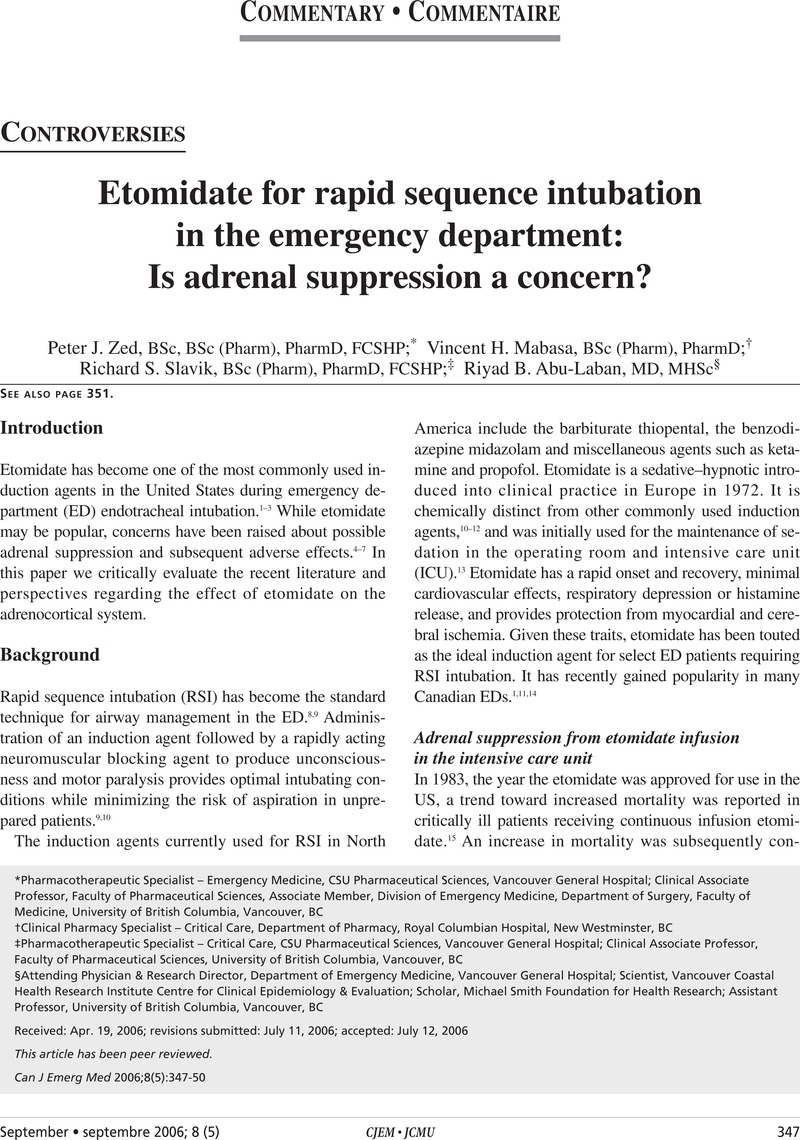Crossref Citations
This article has been cited by the following publications. This list is generated based on data provided by Crossref.
Sivilotti, Marco L.A.
2006.
You need tube, me give one amp of etomidate and SUX.
CJEM,
Vol. 8,
Issue. 05,
p.
351.
Jacoby, Jeanne
and
Heller, Michael
2007.
In reply.
Annals of Emergency Medicine,
Vol. 50,
Issue. 2,
p.
201.
Sivilotti, Marco L.A.
2007.
Reply.
CJEM,
Vol. 9,
Issue. 01,
p.
3.
Green, Rob
2007.
Etomidate and RSI: How important is post-intubation hypotension?.
CJEM,
Vol. 9,
Issue. 01,
p.
3.
Mort, Thomas C
2007.
Anesthesia practice in the emergency department: overview, with a focus on airway management.
Current Opinion in Anaesthesiology,
Vol. 20,
Issue. 4,
p.
373.
Sacchetti, Alfred
2008.
Etomidate: Not Worth the Risk in Septic Patients.
Annals of Emergency Medicine,
Vol. 52,
Issue. 1,
p.
14.
Lee, Ji Hyeon
Lee, Jong Hwan
Chin, Young Jhoon
Lee, Soo Il
Chung, Chan Jong
Lee, Seung Cheol
and
Choi, So Ron
2008.
The effect of fentanyl pretreatment on myoclonus during induction of anesthesia with etomidate in elderly patients.
Korean Journal of Anesthesiology,
Vol. 55,
Issue. 2,
p.
150.
Nestor, Nestor B.
and
Burton, John H.
2008.
ED use of etomidate for rapid sequence induction.
The American Journal of Emergency Medicine,
Vol. 26,
Issue. 8,
p.
946.
Tekwani, Karis L.
Watts, Hannah F.
Rzechula, Kathleen H.
Sweis, Rolla T.
and
Kulstad, Erik B.
2009.
A Prospective Observational Study of the Effect of Etomidate on Septic Patient Mortality and Length of Stay.
Academic Emergency Medicine,
Vol. 16,
Issue. 1,
p.
11.
Koerber, J. P.
Roberts, G. E. W.
Whitaker, R.
and
Thorpe, C. M.
2009.
Variation in rapid sequence induction techniques: current practice in Wales.
Anaesthesia,
Vol. 64,
Issue. 1,
p.
54.
Ching, Kevin Y.
and
Baum, Carl R.
2009.
Newer Agents for Rapid Sequence Intubation.
Pediatric Emergency Care,
Vol. 25,
Issue. 3,
p.
201.
Dutton, Richard P.
2009.
Evidence-Based Practice of Anesthesiology.
p.
121.
Andrade, Fabio M.
2009.
Letter to the Editor: Hypotension after Etomidate Use in Sepsis.
Journal of Korean Medical Science,
Vol. 24,
Issue. 6,
p.
1234.
Andrade, Fabio Moreira
2009.
Postintubation Hypotension: The “Etomidate Paradox”.
Journal of Trauma: Injury, Infection & Critical Care,
Vol. 67,
Issue. 2,
p.
417.
Markovitz, Barry P.
2009.
The drug that would not die (though patients receiving it do)*.
Pediatric Critical Care Medicine,
Vol. 10,
Issue. 3,
p.
418.
Mettauer, Nicole
and
Brierley, Joe
2009.
A novel use of etomidate for intentional adrenal suppression to control severe hypercortisolemia in childhood*.
Pediatric Critical Care Medicine,
Vol. 10,
Issue. 3,
p.
e37.
Burbulys, David
and
Kiai, Kianusch
2010.
Rosen's Emergency Medicine – Concepts and Clinical Practice.
p.
2429.
Dmello, Dayton
Taylor, Stephen
O'Brien, Jacklyn
and
Matuschak, George M.
2010.
Outcomes of Etomidate in Severe Sepsis and Septic Shock.
Chest,
Vol. 138,
Issue. 6,
p.
1327.
Andrade, Fabio Moreira
2010.
Is etomidate really that bad in septic patients?.
Intensive Care Medicine,
Vol. 36,
Issue. 7,
p.
1266.
Tekwani, Karis L.
Watts, Hannah F.
Sweis, Rolla T.
Rzechula, Kathleen H.
and
Kulstad, Erik B.
2010.
A Comparison of the Effects of Etomidate and Midazolam on Hospital Length of Stay in Patients With Suspected Sepsis: A Prospective, Randomized Study.
Annals of Emergency Medicine,
Vol. 56,
Issue. 5,
p.
481.





